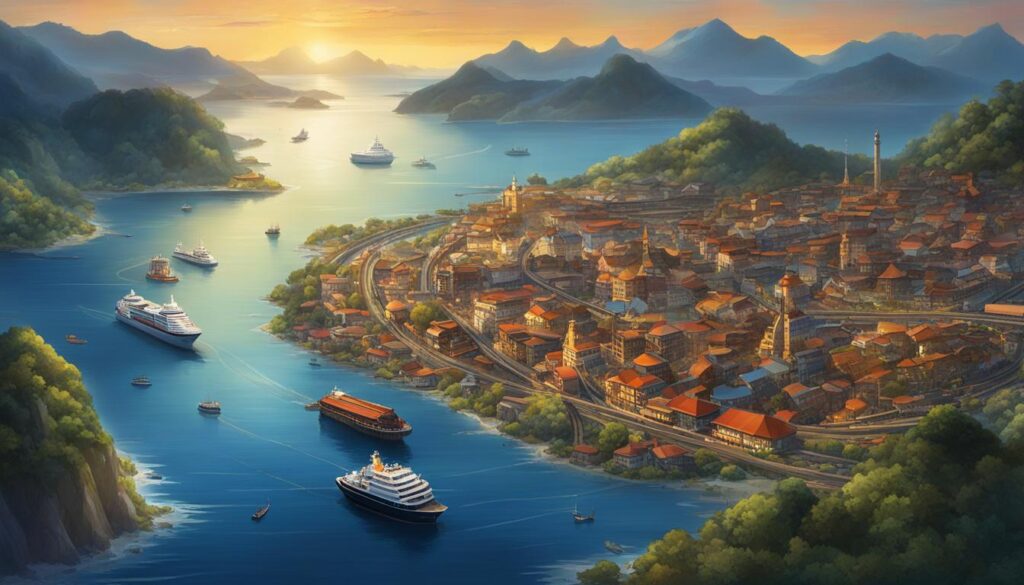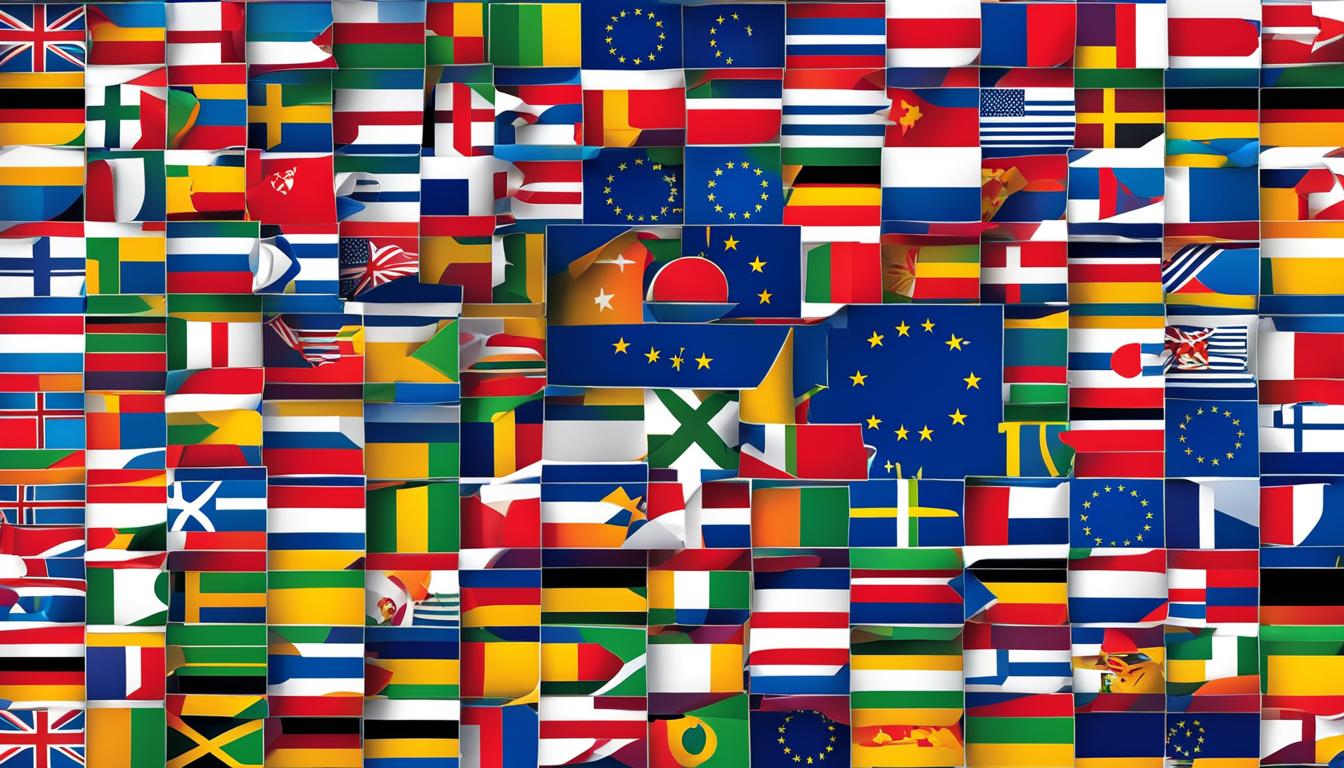Island countries and landlocked countries have distinct geographical characteristics that shape their economies and development. The differences between these two types of countries are evident in their transportation systems, access to resources, and economic opportunities.
Island countries, surrounded by water, have easy access to seaborne trade and are often rich in natural resources. They rely heavily on tourism and benefit from their unique ecosystems and cultural attractions. In contrast, landlocked countries, located far from coastlines, face challenges in terms of trade and transportation. They often struggle with limited resources and higher transit costs due to their lack of territorial access to the sea.
Understanding these differences is crucial for policymakers and stakeholders to develop effective strategies for economic development, trade facilitation, and infrastructure improvement in both types of countries.
Key Takeaways:
- Island countries and landlocked countries have distinct geographical characteristics that impact their economies.
- Island countries have easy access to seaborne trade, rely on tourism, and often have abundant natural resources.
- Landlocked countries face challenges in terms of trade, transportation, and limited resources.
- Developing effective strategies for economic development is crucial for both types of countries.
Economic Challenges of Landlocked Countries
Landlocked countries face significant economic challenges due to their lack of territorial access to the sea. The absence of coastlines limits their ability to engage in seaborne trade, resulting in higher trade costs, longer transit times, and restricted access to global markets.
One of the main economic challenges for landlocked countries is transportation. These nations heavily rely on neighboring countries and international transit routes to reach seaports for import and export activities. This dependency can lead to increased costs and delays in trade due to cumbersome border-crossing procedures and inadequate infrastructure.
The high transportation costs associated with landlocked countries also affect their overall development. Limited connectivity to international markets and longer transit times decrease their competitiveness and hinder economic growth. Additionally, the narrow production base and concentration of commodities and minerals in their exports make these countries more vulnerable to price fluctuations and external shocks.
| Challenges | Solutions |
|---|---|
| High trade costs | Investment in infrastructure, trade facilitation agreements |
| Limited access to global markets | Improving connectivity, promoting regional integration |
| Dependency on neighboring countries | Enhancing transit transport infrastructure, streamlining border-crossing procedures |
| Narrow production base | Diversifying the economy, promoting value-added industries |
Advantages of Island Countries
Island countries have several advantages compared to their landlocked counterparts. Their geographical location provides easy access to seaborne trade, allowing for efficient and cost-effective transportation of goods. This accessibility to global markets contributes to the economic growth and development of island countries. Additionally, the natural resources found in many island countries, such as fisheries and minerals, further stimulate their economies.
One of the significant advantages of island countries is their thriving tourism industry. With beautiful beaches, unique ecosystems, and cultural attractions, these countries attract a large number of tourists every year. Tourism not only generates revenue but also creates job opportunities for the local population. The combination of seaborne trade, natural resources, and tourism makes island countries attractive destinations for investment and development.
To illustrate the advantages of island countries, consider the following table:
| Advantage | Description |
|---|---|
| Easy Access to Seaborne Trade | Island countries have well-developed port infrastructure and established maritime trade routes. |
| Diverse and Thriving Tourism Industry | Island countries attract tourists with their beautiful beaches, unique ecosystems, and cultural attractions. |
| Abundant Natural Resources | Island countries often have fisheries, minerals, and other resources that contribute to their economic growth. |
Challenges Faced by Island Countries
Island countries, despite their numerous advantages, also encounter specific challenges that shape their economic and social landscapes. One of the most pressing challenges faced by these countries is the impact of climate change. Rising sea levels and increased frequency of natural disasters such as hurricanes and tsunamis pose significant threats to the infrastructure and economy of island nations. These events can result in extensive damage, disrupt tourism, and hamper overall development.
Additionally, island countries often face issues of isolation. Due to their geographical location, they can be distant from major markets and global economic centers. This isolation can increase their dependence on imports, leaving them vulnerable to price fluctuations and supply chain disruptions. Limited land area and resources also pose challenges for island countries, making sustainable development and meeting the growing needs of their populations more difficult.
To illustrate the challenges faced by island countries, here is a table that highlights some of the key issues:
| Challenges | Impact |
|---|---|
| Climate change and natural disasters | Infrastructure damage, disruption of tourism, and economic setbacks |
| Isolation | Dependence on imports, vulnerability to price fluctuations, and supply chain disruptions |
| Limited land area and resources | Challenges in sustainable development and meeting the needs of a growing population |
These challenges highlight the need for effective mitigation strategies and long-term planning to ensure the resilience and sustainability of island countries. By addressing climate change, enhancing connectivity, and diversifying their economies, these nations can overcome their challenges and thrive in a rapidly changing world.
Differences in Transportation and Connectivity
Transportation and connectivity play a crucial role in the economic development and trade facilitation of both island countries and landlocked countries. However, there are significant differences in this aspect between the two types of countries.
Transportation Infrastructure:
Island countries typically have well-developed port infrastructure, allowing for efficient maritime trade and easy access to global markets. Their harbors and shipping facilities are designed to accommodate large vessels, promoting the smooth flow of goods. Additionally, island countries often have established air transportation networks that provide convenient international travel options for both tourists and business activities.
In contrast, landlocked countries face challenges in terms of transit routes and infrastructure. They heavily rely on neighboring countries for access to seaports and must navigate through cumbersome border-crossing procedures. This reliance on other countries for trade routes can lead to delays and increased transit costs, affecting the competitiveness of landlocked countries in the global market.
Connectivity to International Markets:
Island countries have a distinct advantage when it comes to connectivity to international markets. Their geographical location provides direct access to major shipping routes, enabling them to easily connect with global trading partners. This accessibility not only facilitates the export of their products but also attracts foreign investment and boosts their overall economic development.
On the other hand, landlocked countries face limitations in terms of connectivity to international markets. The absence of a coastline poses a challenge for these countries to establish direct trade links with the rest of the world. They heavily rely on transit routes provided by neighboring countries, which can be subject to geopolitical factors and impact their ease of doing business.
Overall, the transportation and connectivity differences between island countries and landlocked countries are significant. While island countries benefit from well-developed port infrastructure and easy access to global markets, landlocked countries face challenges in terms of transit routes and reliance on neighboring countries. Understanding these differences is crucial for policymakers and stakeholders to address infrastructure development and trade facilitation needs in both types of countries.
| Island Countries | Landlocked Countries | |
|---|---|---|
| Transportation Infrastructure | Well-developed port infrastructure and established air transportation networks | Reliance on neighboring countries for access to seaports and limited transit routes |
| Connectivity to International Markets | Direct access to major shipping routes and easy connectivity with global trading partners | Reliance on transit routes provided by neighboring countries, subject to geopolitical factors |
Table: Comparison of Transportation and Connectivity between Island Countries and Landlocked Countries

Conclusion
Island countries and landlocked countries have distinct characteristics and face different challenges due to their geographical locations. Island countries benefit from easy access to seaborne trade, abundant natural resources, and thriving tourism industries. However, they also face challenges related to climate change, natural disasters, and limited land area.
On the other hand, landlocked countries struggle with limited access to the sea, higher transit costs, and a narrower production base. These countries rely heavily on neighboring nations for trade and transportation, leading to longer transit times and increased transportation costs.
Understanding these geographical and economic differences is crucial for policymakers and stakeholders. It allows them to develop effective strategies for economic development, trade facilitation, and infrastructure improvement in both island countries and landlocked countries. By addressing the challenges and capitalizing on the advantages of each type of country, sustainable growth and prosperity can be achieved.
FAQ
What are the main differences between island countries and landlocked countries?
Island countries are surrounded by water and have easy access to seaborne trade, while landlocked countries are located far from coastlines and face challenges in terms of trade and transportation.
What are the economic challenges faced by landlocked countries?
Landlocked countries rely on other countries for their seaborne trade, which involves dealing with cumbersome border-crossing procedures and inadequate transit transport infrastructure. This results in higher trade costs and longer transit times, impacting their overall economic development.
What advantages do island countries have?
Island countries have easy access to seaborne trade, diverse and thriving tourism industries, and abundant natural resources, such as fisheries and minerals, which contribute to their economic growth.
What challenges do island countries face?
Island countries are vulnerable to the effects of climate change and natural disasters, such as rising sea levels and hurricanes. They often face isolation from major markets, dependence on imports, and limited land area and resources.
How do transportation and connectivity differ between island countries and landlocked countries?
Island countries typically have well-developed port infrastructure and established air transportation networks, allowing for efficient maritime trade and easy access to global markets. In contrast, landlocked countries face challenges in terms of transit routes and infrastructure, resulting in longer transit times, higher transport costs, and limited connectivity to international markets.
 Skip to main content
Skip to main content


